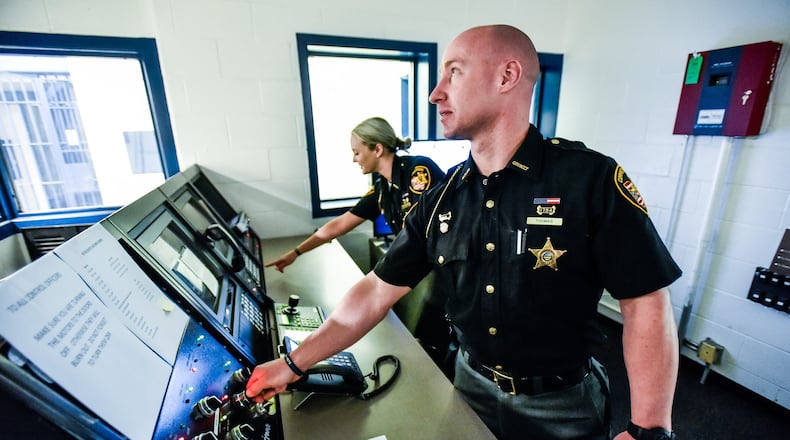The general fund has been structurally balanced for eight years, meaning officials have not dipped into reserves to balance. Including all of the other revenues and expenses, from individual departments that operate on their own levies and or state and federal funding or revenue generators like water and sewer, the total proposed budget revenues are $628.5 million, and expenses are $408.8 million. The total unencumbered fund balance is expected to be $219.6 million at the end of next year.
In the past few years as finances have improved, the county faced several challenges, like how to fund new voting machines, pay for the estimated $19.2 million emergency response radios — the early estimate was ultimately halved — and deal with the loss of $3.2 million Medicaid managed care sales tax.
County Administrator Judi Boyko said overall everything looks positive now.
“Looking out toward the 2020 horizon, it appears that county operations, county revenue sources are stable,” Boyko said. “The county and all jurisdictions in the state of Ohio have benefited from the governor’s biennium budget where the governor reinstated certain funding sources.”
Most of the offices in the criminal justice system will have hearings Monday, and that is an area where the county has benefited from the governor’s actions.
The sheriff has the biggest budget at just shy of $40 million. In her tax budget submission, Finance Director Vickie Barger included 23 additional full-time staff (the staff increase in the final budget is 11), bringing the total to 410. She noted having three jails in operation prompted the need for additional staff.
Chief Deputy Anthony Dwyer said the tax budget request was honed so the number of additional corrections officers has decreased, but the number is always a moving target.
RELATED: Butler County reopens shuttered jail to prepare for new law
“We have a lot of contract inmates, and that’s one of the things we always talk about, the tipping point between our part-time staff we have versus the full-time staff to get the job done,” Dwyer said. “We have a great amount of turnover in corrections so those numbers can fluctuate so quickly in, like a month. I’m literally hiring somebody every other week.”
When a new law went into effect last year that curbed judges’ ability to send felony five offenders to prison, it wasn’t clear if state funding would cover it or if it was a permanent source of funding. Gov. Mike DeWine continued the funding, and the county will receive $2.4 million through 2022 for the Targeted Community Alternatives to Prison.
The governor also more than doubled the reimbursement for public defenders. The funding is projected to go from 42 percent this year to 90 percent in July 2020. Public Defender Michael Weisbrod submitted a $2.7 million budget and noted even though the office plans to add seven part-time assistant public defenders and five administrative positions to handle the new case management system, the 2020 budget is $481,000 less over last year.
Boyko said the state’s implementation of the Marketplace facilitator law could boost sales tax — the county general fund largest revenue source — but she is not counting on it to be a huge amount of money. Lawmakers inserted in the biennial budget bill a provision that requires out-of-state vendors who sell more than $100,000 and/or 200 orders in a year charge and collect Ohio sales tax.
“Candidly, I thought initially when the internet sales tax was approved, my initial reaction was wow, that’s going to be a waterfall of new sales tax revenue,” Boyko said, adding since many retailers have already been collecting and remitting the sales tax, “I don’t believe the internet sales tax provision in the biennium budget is going to be as significant or substantial as we once thought. However, every little bit helps.”
MORE: Next year’s budget means one big thing: No more debt for Butler County
There is one thing the state had nothing to do with is the fact the debt will be erased after next year. The county does have non-general fund debt that will continue to be paid through special assessments, tax increment financing and other sources.
The debt-free plan was adopted by the commissioners in 2015. Prior to that commitment, the debt, which stood at $91.3 million in 2009, was scheduled for payments out to 2033. The commissioners want to use some of the money to promote economic development countywide.
“We’re going to get through this budget and begin our plans about infrastructure, building maintenance, building utilization, looking ahead for the next five years,” Commissioner T.C. Rogers said about the money that will be freed up. “With that comes the responsibility of what are you going to do with it. Everybody will want some of it.”
The biggest county expense is for personnel, and a big part of how the county got back on track was instituting a pay-for-performance plan. Double-digit raises and multiple raises in a year used to be the norm and caused “serious problems with the budget,” Commissioner Don Dixon said. Some officeholders have asked for more people and bigger raises than the guidelines outlined.
“The number of employees is what really puts the pressure on the budget,” Dixon said. “We just have to look at a case-by-case scenario. They’ll make their case and we’ll look at it.”
About the Author
